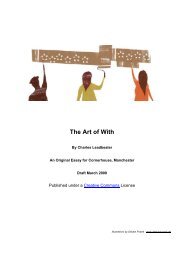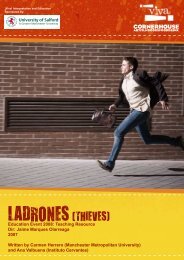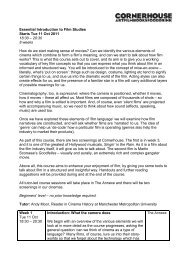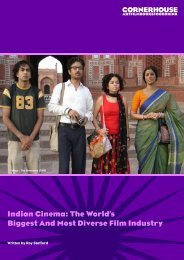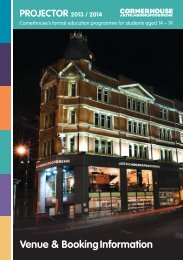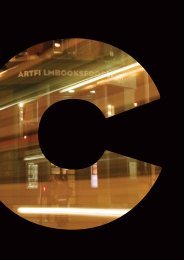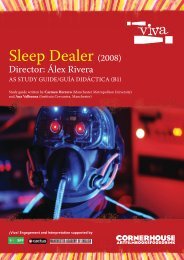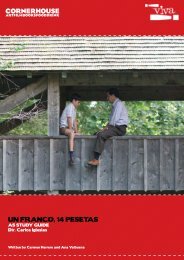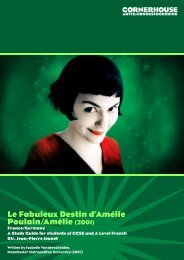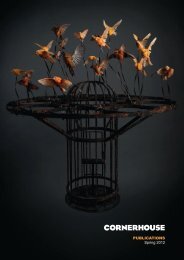Use film to teach languages - Cornerhouse
Use film to teach languages - Cornerhouse
Use film to teach languages - Cornerhouse
You also want an ePaper? Increase the reach of your titles
YUMPU automatically turns print PDFs into web optimized ePapers that Google loves.
A <strong>teach</strong>ers’ <strong>to</strong>olkit for educa<strong>to</strong>rs wanting <strong>to</strong> <strong>teach</strong> <strong>languages</strong><br />
using <strong>film</strong> in the classroom, with a particular focus on Arabic,<br />
Mandarin, Italian and Urdu.<br />
Teachers’ Toolkit written by Deborah Chan and Dr. Carmen Herrero<br />
Projec<strong>to</strong>r: Community Languages<br />
is supported by:<br />
in collaboration with Routes in<strong>to</strong><br />
Languages North West (COLT)<br />
st
This document discusses the Projec<strong>to</strong>r: Community<br />
Languages project and is a <strong>to</strong>olkit aimed at <strong>teach</strong>ers and<br />
educa<strong>to</strong>rs wanting <strong>to</strong>:<br />
> <strong>Use</strong> <strong>film</strong> <strong>to</strong> <strong>teach</strong> <strong>languages</strong><br />
> Understand the value of <strong>film</strong> education and the<br />
positive impact it has on learning <strong>languages</strong>,<br />
particularly community and lesser taught<br />
<strong>languages</strong><br />
> Explore the <strong>languages</strong> and cultures of Arabic,<br />
Mandarin, Urdu and Italian<br />
> Acquire the necessary <strong>to</strong>ols, resources and<br />
knowledge <strong>to</strong> interpret a <strong>film</strong> and how <strong>to</strong> link it<br />
<strong>to</strong> the National Curriculum<br />
> Learn new ideas on how <strong>to</strong> create practical<br />
language exercises, using feature <strong>film</strong>s,<br />
documentaries and short <strong>film</strong>s<br />
1
Contents<br />
1. INTRODUCTION<br />
Cinema-Based Study Sessions<br />
Study Guides<br />
Creative Workshops<br />
2. LANGUAGES AND FILM IN THE SCHOOL CURRICULUM<br />
3. THEORETICAL AND CRITICAL APPROACHES TO UNDERSTANDING FILM AS A<br />
RESOURCE FOR TEACHING LANGUAGES<br />
3.1 Multimodal Pedagogies: Learning and Teaching Languages through Film<br />
3.2 Advantages <strong>to</strong> using <strong>film</strong> <strong>to</strong> <strong>teach</strong> <strong>languages</strong><br />
3.4 How <strong>to</strong> select <strong>film</strong>s and what <strong>to</strong> consider<br />
3.5 How <strong>to</strong> analyse a <strong>film</strong><br />
3.6 Conclusion<br />
4. FILMS FOR THE CLASSROOM<br />
5. HOW TO DEVELOP CREATIVE LANGUAGE EXERCISES<br />
5.1 Ideas for Mandarin Teachers<br />
5.2 Ideas for Arabic Teachers<br />
6. HOW TO ANALYSE A SCENE<br />
6.1 Sample Film/Clip Analysis/ Ideas for Urdu Teachers<br />
7. USING SHORT FILMS<br />
7.1 Ideas for Italian Teachers<br />
8. APPENDICES<br />
Appendix A:<br />
Appendix B:<br />
Appendix C:<br />
Appendix D:<br />
Appendix E:<br />
Activity Form<br />
Film/ Clip Analysis Form<br />
Original material produced by the Mandarin <strong>teach</strong>ers<br />
Original material produced by the Arabic <strong>teach</strong>ers<br />
Original material produced by the Italian <strong>teach</strong>ers<br />
9. REFERENCES<br />
2
1. Introduction<br />
In February 2010, part of Projec<strong>to</strong>r: Community<br />
Languages, <strong>Cornerhouse</strong> and Routes In<strong>to</strong><br />
Languages North West (COLT) organised an<br />
INSET (In-Service Education and Training) day<br />
called Using Film To Teach Languages, aimed<br />
specifically at <strong>teach</strong>ers of community and<br />
lesser taught <strong>languages</strong> - Arabic, Mandarin,<br />
Urdu and Italian. Focusing on four very<br />
different and complex <strong>languages</strong> was very<br />
ambitious, but the event proved extremely<br />
successful in providing <strong>teach</strong>ers with the<br />
basic foundations <strong>to</strong> explore and interpret<br />
<strong>film</strong>, finding ways <strong>to</strong> link it <strong>to</strong> the curriculum,<br />
as well as offering practical suggestions and<br />
ideas for developing language activities <strong>to</strong> be<br />
applied in the classroom. The event attracted<br />
language <strong>teach</strong>ers and trainees from across<br />
the UK <strong>to</strong> whom we are very grateful for<br />
allowing us <strong>to</strong> share and present their ideas<br />
and findings as a way <strong>to</strong> inspire other <strong>teach</strong>ers<br />
<strong>to</strong> use <strong>film</strong> <strong>to</strong> enhance language learning.<br />
Without the enthusiasm and involvement<br />
from all the <strong>teach</strong>ers and the language<br />
facilita<strong>to</strong>rs (listed on page 33), this <strong>to</strong>olkit<br />
would not have been possible, so thank you.<br />
Projec<strong>to</strong>r: Community Languages was a<br />
pilot project initiated by <strong>Cornerhouse</strong> and<br />
Routes In<strong>to</strong> Languages North West (COLT)<br />
during August 2009 - April 2010. The aim was<br />
<strong>to</strong> increase access <strong>to</strong> <strong>film</strong> education for young<br />
people (aged 14-19 years) and <strong>to</strong> explore the<br />
cultures and <strong>languages</strong> spoken within the<br />
diverse communities of the North West region,<br />
with a particular focus on community and<br />
lesser taught <strong>languages</strong> - Arabic, Mandarin,<br />
Urdu and Italian. With support from Film:<br />
21st Film Century Literacy and the UK Film<br />
Council, this was the first time we had<br />
formally introduced these four <strong>languages</strong><br />
in<strong>to</strong> <strong>Cornerhouse</strong>’s education programme,<br />
where cinema-based study sessions and<br />
creative workshops were offered <strong>to</strong> students,<br />
as well as providing continuing professional<br />
development opportunities for <strong>teach</strong>ers and<br />
other professionals wanting <strong>to</strong> deliver <strong>film</strong>related,<br />
language learning sessions.<br />
3
The Cinema-Based Study Sessions<br />
involved a subtitled <strong>film</strong> screening in<br />
the target language, aimed at GCSE and<br />
AS/A2 level learners. With the support<br />
of a bespoke study guide, the sessions<br />
were led by <strong>film</strong> and language specialists<br />
who delivered pre, during and postscreening<br />
exercises relating <strong>to</strong> the <strong>film</strong><br />
and linked <strong>to</strong> the National Curriculum.<br />
Young people had the opportunity<br />
<strong>to</strong> develop a better understanding of<br />
other people’s cultures, way of life and<br />
his<strong>to</strong>ry, by watching <strong>film</strong>s they would<br />
not normally have access <strong>to</strong>. Learners<br />
were encouraged <strong>to</strong> think critically and<br />
look beyond the surface of the screen <strong>to</strong><br />
consider the <strong>film</strong>s’ intentions, techniques<br />
and qualities; and in the target language<br />
young people were encouraged <strong>to</strong><br />
discuss issues and themes explored in<br />
the <strong>film</strong> <strong>to</strong> enhance their language skills<br />
and widen their vocabulary.<br />
Each of the Study Guides contained background<br />
information about the <strong>film</strong> and direc<strong>to</strong>r, ideas for<br />
linguistic, visual and cultural exercises and other<br />
resources relating <strong>to</strong> <strong>film</strong> and language. The guides<br />
produced for Projec<strong>to</strong>r: Community Languages are<br />
available for <strong>teach</strong>ers and students <strong>to</strong> download<br />
from our website: http://www.cornerhouse.org/<br />
resources<br />
A Thousand Months (2003)<br />
GCSE Arabic Study Guide<br />
AS/A2 Arabic Study Guide<br />
Jodhaa Akbar (2008)<br />
AS/A2 Urdu Study Guide<br />
Little Red Flowers (2006)<br />
GCSE Mandarin Study Guide<br />
The Road Home (2000)<br />
GCSE Mandarin Study Guide<br />
4<br />
Mid-August Lunch (2008)<br />
GCSE Italian Study Guide
Creative Workshops involved the integration of<br />
Information and Communication Technology<br />
(ICT) and <strong>film</strong>making techniques with language<br />
learning. This was an excellent opportunity for<br />
young people <strong>to</strong> work alongside an artist and<br />
<strong>film</strong>maker <strong>to</strong> develop creative responses <strong>to</strong> the<br />
<strong>film</strong>s and <strong>to</strong> apply their language skills in unique<br />
and interesting ways. A language specialist<br />
would ensure the workshops were relevant <strong>to</strong><br />
the National Curriculum and linked <strong>to</strong> the <strong>to</strong>pic<br />
areas outlined in the language specifications<br />
(e.g. cus<strong>to</strong>ms, everyday life and traditions), as well<br />
as expanding vocabulary and ensuring students<br />
communicated accurately and at a high<br />
standard. Using <strong>film</strong> as a vehicle for creativity,<br />
young people had access <strong>to</strong> state of the art<br />
equipment and professional staff, where learning<br />
<strong>to</strong>ok place in an informal and open environment.<br />
As a result of our creative workshops, a variety<br />
of animated <strong>film</strong>s were produced, of which<br />
one <strong>film</strong> was screened as part of the Liverpool<br />
Arabic Arts Festival (Jul 2010) and two <strong>film</strong>s were<br />
entered in<strong>to</strong> LAFTAs - Languages and Film Talent<br />
Awards under the new ‘A World of Languages’<br />
category. To view the animated <strong>film</strong>s, produced<br />
by hardworking students learning Arabic,<br />
Mandarin, Urdu and Italian, visit our website:<br />
http://www.cornerhouse.org/CLanimation<br />
If you are a <strong>teach</strong>er interested in our Creative<br />
Workshops and would like a cus<strong>to</strong>mised session<br />
<strong>to</strong> take place in your school, centre or college,<br />
please email engagement@cornerhouse.org for<br />
a quote and further details.<br />
5
2. Languages and Film in the<br />
School Curriculum<br />
Languages are part of the cultural richness of our society and the world in which we live and work.<br />
The importance of learning <strong>languages</strong> has become more significant over the last decade. Not only<br />
does it contribute <strong>to</strong>wards the development of individual intelligence, but learning a new language<br />
gives us access <strong>to</strong> another culture and prepares us with the essential skills <strong>to</strong> succeed and adapt in a<br />
rapidly changing, globalised world. With growing economies, like China, learning Mandarin has become<br />
increasingly popular in schools - with one in seven now <strong>teach</strong>ing the subject (2010).<br />
From 2011, <strong>languages</strong> will become a compulsory subject in the new primary curriculum, with the aim<br />
<strong>to</strong> inspire an interest in <strong>languages</strong> from an early age. There is emphasis on developing young people’s<br />
intercultural understanding by looking at the different <strong>languages</strong> spoken in different parts of the UK and<br />
the world, and how different cultures are represented in the media and popular cultural forms, including<br />
<strong>film</strong>.<br />
[http://curriculum.qcda.gov.uk/new-primary-curriculum/index.aspx]<br />
The secondary curriculum, Key Stages 3 and 4, focuses on four key concepts that underpin the study of<br />
<strong>languages</strong>: linguistic competence, knowledge about language, creativity and intercultural understanding.<br />
One of the speaking achievements (Level 8) invites pupils <strong>to</strong> speak about the plot of a <strong>film</strong> and <strong>to</strong> give<br />
their opinions. In both stages, the use of <strong>film</strong>s in the language classroom can encourage a creative<br />
approach that can have applications across the curriculum.<br />
[http://curriculum.qcda.gov.uk/key-stages-3-and-4/subjects/key-stage-3/modern-foreign-<strong>languages</strong>/index.aspx].<br />
The use of <strong>film</strong> is a key component found in the new GCSE Modern Foreign Languages syllabus<br />
specification, and Cinema is one of the sub-<strong>to</strong>pics included under the area of Popular Culture for the new<br />
AQA examination for AS Modern Foreign Languages. Therefore, students should be able <strong>to</strong> communicate<br />
confidently about:<br />
- different <strong>film</strong> types<br />
- changing trends<br />
- cinema within popular culture<br />
- a good <strong>film</strong> they have seen<br />
- their personal preferences between cinema and alternative ways of viewing <strong>film</strong>s.<br />
[http://s<strong>to</strong>re.aqa.org.uk/qual/gce/pdf/AQA-2650-2660-2695-W-SP-10.PDF]<br />
[Similar models can be found in EDEXCEL: http://www.edexcel.com/subjects/<strong>languages</strong>/Pages/Qualifications.aspx<br />
and WEJC: http://www.wjec.co.uk/uploads/publications/6951.pdf ]<br />
For the A2 language specifications, as part of the Cultural Topics, learners have the opportunity <strong>to</strong> study<br />
a <strong>film</strong> direc<strong>to</strong>r from a target language-speaking country or community. The sub-<strong>to</strong>pics invite students <strong>to</strong><br />
think about the <strong>film</strong>maker’s influences, discuss the ideas, themes, techniques and the style of their <strong>film</strong>s<br />
and <strong>to</strong> make a personal evaluation of his/her work.<br />
For Arabic, the GCSE <strong>to</strong>pic areas include Cinema under the section media, entertainment and youth<br />
culture; and the AS/A2 <strong>to</strong>pics included under Culture (art, architecture, music and entertainment) or Sociocultural<br />
aspects of study (cus<strong>to</strong>ms and traditions, the role of women, religion and social issues) can be<br />
studied through <strong>film</strong>. Two of the novels incorporated for study: Naguib Mahfouz’s al-Liss wa al-Kilab (The<br />
Thief and the Dogs, 1961) and Yahya Haqqi Qindil Umm Hashim (The Saint’s Lamp, 1944) were adapted for<br />
the screen and available as <strong>film</strong>s.<br />
[http://www.edexcel.com/migrationdocuments/Current%20GCSE/261927_Arabic_AB_1606_7_.pdf ]<br />
[http://developments.edexcel.org.uk/VirtualContent/103876/Arabic1.pdf ]<br />
6
The GCE Chinese specification indicates that students should write an essay in Chinese (500—1000<br />
characters) that relates <strong>to</strong> individual research undertaken and links <strong>to</strong> Chinese culture and/or society.<br />
Two <strong>film</strong>s are specified (Unit 3): Nan Hai 13 (Mad Phoenix, 1997)) by Clif<strong>to</strong>n Ko Chi-Sum and Han Yan Cui<br />
(Mist Over Dream Lake, 1968) by Yen Chun. Nevertheless, <strong>film</strong>s could be included for the study of other<br />
<strong>to</strong>pics: China’s traditions, festivals and cus<strong>to</strong>ms; Confucianism or Taoism (Daoism) (discussion of the basic<br />
principles of either philosophical tradition in Chinese society); women’s issues or generation gap issues in<br />
China (1911 <strong>to</strong> the present).<br />
[http://developments.edexcel.org.uk/VirtualContent/103294/Summary_spec_chinese.pdf ]<br />
Students must contribute <strong>to</strong> a discussion about a simple subject and are asked <strong>to</strong> give a short talk about<br />
a straightforward subject using an image for the Edexcel GCSE Chinese specification. This is an excellent<br />
opportunity <strong>to</strong> choose a <strong>film</strong> or different types of <strong>film</strong> as the <strong>to</strong>pic for discussion and <strong>to</strong> focus on a <strong>film</strong> or<br />
an issue explored in a <strong>film</strong>, using an image (e.g. <strong>film</strong> still or <strong>film</strong> poster) as part of the short talk.<br />
[http://www.edexcel.com/migrationdocuments/Current%20GCSE/262345_Chinese_A_B_1666_7_v2.pdf ]<br />
For Urdu, the GCSE AQA specification includes Cinema as part of the Leisure <strong>to</strong>pic, where learners are<br />
asked <strong>to</strong> talk about the <strong>film</strong>s they like and who their favourite ac<strong>to</strong>rs/actresses are and why. For AS/A2,<br />
students are required <strong>to</strong> write a research-based essay in Urdu based on an area of interest, that could<br />
include <strong>film</strong>, where they need <strong>to</strong> demonstrate an understanding of different characters, key issues, social<br />
and cultural settings and the styles/ techniques employed in the <strong>film</strong>. This also applies <strong>to</strong> AS/A2 Italian,<br />
where students have <strong>to</strong> write a research-based essay in Italian also linked <strong>to</strong> an area of interest and one of<br />
those possible areas is <strong>film</strong>.<br />
[http://s<strong>to</strong>re.aqa.org.uk/qual/newgcse/pdf/AQA-4645-W-SP-11.PDF]<br />
[http://www.edexcel.com/migrationdocuments/GCE%20New%20GCE/spec-gce-urdu.pdf ]<br />
[http://www.edexcel.com/migrationdocuments/GCE%20New%20GCE/spec-gce-italian.pdf ]<br />
7
3. Theoretical and critical<br />
approaches <strong>to</strong> understanding<br />
<strong>film</strong> as a resource for<br />
<strong>teach</strong>ing <strong>languages</strong><br />
The <strong>teach</strong>ers’ INSET Using Film To Teach Languages was facilitated by Dr. Carmen Herrero, Principal Lecturer<br />
in Spanish Studies, based at Manchester Metropolitan University. She has worked for <strong>Cornerhouse</strong> as<br />
programme advisor for their ¡Viva! Spanish and Latin American Film Festival [http://www.viva<strong>film</strong>festival.<br />
com] and <strong>teach</strong>er training advisor for Projec<strong>to</strong>r: Community Languages. For the last ten years, she has<br />
contributed <strong>to</strong> <strong>Cornerhouse</strong>’s formal education programme by producing extensive study guides for<br />
<strong>teach</strong>ers and students of Spanish wanting a more flexible and imaginative approach <strong>to</strong> <strong>teach</strong>ing and<br />
learning <strong>languages</strong> through <strong>film</strong>. She is also co-founder of FILTA (Film in Language Teaching Association)<br />
[www.filta.org.uk].<br />
Herrero’s research focuses on multimodal literacy and New Literacies applied <strong>to</strong> learning and <strong>teach</strong>ing<br />
<strong>languages</strong>. Her recent articles deal with multimodal literacy and Spanish language <strong>teach</strong>ing, intercultural<br />
communication and language through <strong>film</strong>, genre (particularly thriller) and representations of<br />
motherhood and nostalgia in contemporary Spanish cinema. She has written over thirty study guides<br />
using <strong>film</strong> for <strong>teach</strong>ing Spanish, some of them co-written with Ana Valbuena, tu<strong>to</strong>r at the Institu<strong>to</strong><br />
Cervantes in Manchester.<br />
3.1 Multimodal Pedagogies: Learning and Teaching<br />
Languages through Film<br />
In the ‘new media age” (Kress, 2003), characterised by rapidly changing forms of multimodal<br />
communication in the mass media, multimedia and internet, the importance of multiliteracies has been<br />
highlighted by pedagogical researchers and educational bodies. The term ‘multiliteracies’ was coined by<br />
the New London Group (NLG), a group of academics who were concerned by how literacy pedagogy<br />
might address the rapid change in literacy due <strong>to</strong> globalization, technology and increasing cultural and<br />
social diversity. To be multiliterate is the ability <strong>to</strong> read textual messages, as well as being able <strong>to</strong> interpret<br />
symbols and images. A jointly authored paper, ‘Pedagogy of Multiliteracies’ (The New London Group, 1996),<br />
was an outcome of their discussions that has generated new debates on development of the curriculum.<br />
In their paper, they argue that literacy pedagogy should be linked with the changing social environment<br />
calling ‘for a much broader view of literacy than portrayed by traditional language-based approaches’. At<br />
the same time, they recognise the increasing cultural and linguistic diversity, proposing through the use of<br />
multiliteracies a fairer social and cultural participation. Therefore, they emphasise the importance of looking<br />
for new approaches <strong>to</strong> pedagogy that will help students in understanding how <strong>to</strong> negotiate the multiple<br />
linguistic and cultural differences that exist in our world (The New London Group, 1996: 60). They proposed<br />
that education has <strong>to</strong> consider the multiple channels of communication and media, and ‘must account<br />
for the burgeoning variety of text forms associated with information and multimedia technologies’ (1996:<br />
61). Their framework promotes an approach <strong>to</strong> <strong>teach</strong>ing that situates practice on students’ actual texts,<br />
practices, and skills; that explicitly links abilities that students possess inside and outside of school.<br />
The New London Group was taking in<strong>to</strong> account the increasing role of the visual by recognizing the<br />
multiple modes affiliated with multimedia technology in learners’ meaning-making process. Gunther Kress<br />
8
and Theo van Leeuwen (2001) challenged the traditional view on language’s central or dominant role in<br />
<strong>teach</strong>ing and learning. They argued that other modes of communication, such as image, gesture, music,<br />
spatial and bodily codes, could also contribute <strong>to</strong> the multimodal ways of meaning-making and knowledge<br />
construction. The New London Group identifies six design elements in the meaning-making process (see<br />
diagram Multiliteracies Framework):<br />
Linguistic Design<br />
Visual Design<br />
Audio Design<br />
Gestural Design<br />
•<br />
Spatial Design<br />
•<br />
Multimodal Design (a combination of the above semiotic codes)<br />
Texts may employ one or more semiotic (sign, symbol, code) systems. Therefore, multimodality is the<br />
combination of different kinds of modes—visual, written, oral, spatial etc —in a text’s content and design,<br />
as the linguistics resources are only one of the modes involved in the making of the overall meaningmaking<br />
process. Multimodality can be found in all kind of texts, including <strong>film</strong>, which is multimodal by<br />
nature. Nevertheless, multimodality, as Gunter Kress, points out, can tell us about ‘what modes are used’, but<br />
not about the difference in style and what the difference could mean. Kress proposed the Social Semiotics,<br />
a theory that complements multimodality as it ‘deals with meaning in all its appearances, in all social<br />
occasions and in all cultural sites’ (Kress, 2010: 1-2).<br />
The New London Group multiliteracies framework (below), includes six modes (designs) of meaningmaking:<br />
VISUAL DESIGN<br />
Elements of language/<br />
linguistic meaning including:<br />
• Delivery<br />
• Vocabulary and metaphor<br />
• Modality<br />
• Transitivity<br />
• Nominalisation of processes<br />
• Information structure<br />
• Local coherence relations<br />
LINGUISTIC DESIGN<br />
• Global coherence<br />
relations<br />
Elements of visual meaning,<br />
such as:<br />
• Colours<br />
• Perspective<br />
• Vec<strong>to</strong>rs<br />
• Foregrounding and<br />
backgrounding<br />
• Etc<br />
MULTIMODAL DESIGN<br />
MODE OF MEANING<br />
SOME<br />
DESIGN<br />
ELEMENTS<br />
Elements that constitute:<br />
• Music<br />
• Sound effects<br />
• etc.<br />
Elements that constitute:<br />
• Behaviour<br />
• Bodily physicality<br />
• Gesture<br />
• Sensuality<br />
• Feelings and affect<br />
• Kinesics<br />
• Proxemics<br />
• Etc<br />
GESTURAL DESIGN<br />
AUDIO DESIGN<br />
MODE OF MEANING<br />
The integrated meaning making systems of electronic multimedia texts, regarded by the NLG as the most significant, involves reading of all designs in interactive, dynamic ways.<br />
MODE OF MEANING<br />
MODE OF MEANING<br />
Elements that constitute:<br />
• Ecosystem and geographical<br />
meanings<br />
• Architec<strong>to</strong>nic meanings<br />
• Etc<br />
MODE OF MEANING<br />
SPATIAL DESIGN<br />
Redesigned by decafnomilk.com based on the diagram from Cope and Kalantzis (2000)<br />
[Source: http://www.readingonline.org/newliteracies/rush/]<br />
9
The semiotics of multimodality (Jewitt & Kress, 2003; Kress, 2003; Kress, 2010; Kress & Van Leeuwen, 2001) is<br />
one of the dimensions of New Literacies Studies that focuses on how the Internet and other Information and<br />
Communication Technologies (ICTs) are redefining learning and literacy in the 21st century. The complex<br />
and rich media landscape of Web 2.0 is shaping literacy education. Young people seem <strong>to</strong> engage more<br />
and in greater numbers with technological popular media (e.g. video games, computer-based activities and<br />
computer programming), thus developing the skills and confidence in navigating digital spaces and new<br />
technological <strong>to</strong>ols. As students are becoming avid media consumers and crea<strong>to</strong>rs by using the Internet,<br />
Henry Jenkins has noted how participa<strong>to</strong>ry culture has shifted the focus of literacy from one of individual<br />
expression <strong>to</strong> community involvement. In the White Paper Confronting the Challenges of Participa<strong>to</strong>ry<br />
Culture: Media Education for the 21st Century (2006), Jenkins and his colleagues from Massachusetts Institute<br />
of Technology (MIT) have articulated a new skill set, which is contextualized within the digital media<br />
environment that involves social skills developed through collaboration and networking.<br />
Building on the foundation of traditional literacy, research skills, technical skills and critical analysis skills<br />
taught in the classroom, here is a list of the new media literacy skills needed for students in the 21st century<br />
<strong>to</strong> fully engage in <strong>to</strong>day’s participa<strong>to</strong>ry culture:<br />
Performance<br />
Play<br />
The capacity <strong>to</strong><br />
experiment with one’s<br />
surroundings as a form<br />
of problem-solving<br />
The ability <strong>to</strong> adopt<br />
alternative identities<br />
for the purpose of<br />
improvisation<br />
and discovery<br />
Simulation<br />
The ability <strong>to</strong> interpret and<br />
construct dynamic models of<br />
real-world processes<br />
Appropriation<br />
The ability <strong>to</strong><br />
meaningfully sample<br />
and remix media content<br />
Multitasking<br />
The ability <strong>to</strong> scan<br />
one’s environment and<br />
shift focus as needed <strong>to</strong><br />
salient details<br />
Collective<br />
Intelligence<br />
The ability <strong>to</strong> pool knowledge<br />
and compare notes with<br />
others <strong>to</strong>ward a<br />
common goal<br />
Distributed<br />
Cognition<br />
The ability <strong>to</strong> interact<br />
meaningfully with <strong>to</strong>ols<br />
that expand<br />
mental capacities<br />
Transmedia<br />
Navigation<br />
The ability <strong>to</strong> follow<br />
the flow of s<strong>to</strong>ries<br />
and information<br />
across multiple<br />
modalities<br />
Judgment<br />
The ability <strong>to</strong> evaluate<br />
the reliability and<br />
credibility of different<br />
information sources<br />
Networking<br />
The ability <strong>to</strong> search<br />
for, synthesize, and<br />
disseminate information<br />
Negotiation<br />
The ability <strong>to</strong> travel across<br />
diverse communities,<br />
discerning and respecting<br />
multiple perspectives, and<br />
grasping and following<br />
alternative norms<br />
[Source: http://www.newmedialiteracies.org/files/working/NMLWhitePaper.pdf & http://newmedialiteracies.org/]<br />
10
To prepare students for the challenges presented by our globalised, networked, culturally diverse world,<br />
educa<strong>to</strong>rs should put in<strong>to</strong> practice strategies and activities that underpin the new media literacies<br />
involved in accessing, analyzing, interpreting, understanding and creating visual messages in a multimedia<br />
environment. Therefore these experiences with technology need <strong>to</strong> be recognised by language <strong>teach</strong>ers<br />
as valuable and powerful learning <strong>to</strong>ols that should be incorporated in<strong>to</strong> school-based practices.<br />
Due <strong>to</strong> the increasing importance of visual and media images, <strong>film</strong>s have a great potential in the language<br />
classroom, as they bring ‘<strong>to</strong>gether a large variety of modes’ (Kress, 2010: 30). Films are rich multimodal texts<br />
containing linguistic meaning, but they also contain other modes that are sometimes more difficult <strong>to</strong><br />
illustrate or provide in the standard language lesson, such as the gestural component. Films are perfect<br />
vehicles for introducing students <strong>to</strong> different types of popular culture and engaging them with critical<br />
questions about the relationship between information and power, through the critical analysis of sociopolitical<br />
issues and intercultural relationships.<br />
The study guides (mentioned on page 4) designed specially for each <strong>film</strong> offer materials developed <strong>to</strong><br />
encourage students <strong>to</strong> learn the target language by exploring the <strong>film</strong> and its context, as well as learning<br />
about the <strong>film</strong>ic codes and conventions. The resources and materials available from the Internet encourage<br />
students <strong>to</strong> engage with a variety of literacy practices. The new literacies that children and young learners<br />
engage with are multimodal, therefore our proposal for <strong>teach</strong>ing <strong>languages</strong> through <strong>film</strong> is based on<br />
this multimodal model. Films can be the starting point for projects where the <strong>teach</strong>ing and learning of<br />
<strong>languages</strong> are part of a broader strategy that encourages an interdisciplinary and cross-curricula focus,<br />
based on the development of the new literacy skills mentioned earlier.<br />
3.2 Advantages of using <strong>film</strong> <strong>to</strong> <strong>teach</strong> <strong>languages</strong><br />
Visual literacy (the ability <strong>to</strong> interpret and create visual, digital, and audio media) is a fundamental form of<br />
literacy in the 21st Century. The use of <strong>film</strong> in the classroom or as an outside school activity can uphold the<br />
motivation of the learners, because of its playful component. Using <strong>film</strong>s through specific task activities<br />
provides an ideal vehicle for active learning, as well as encouraging interaction and participation. The<br />
communicative potential of its use has been commended:<br />
– it facilitates comprehension activities that are perceived as ‘real’;<br />
– it creates a curiosity gap that facilitates the exchange of opinions and ideas about the <strong>film</strong>;<br />
– it helps <strong>to</strong> explore non-verbal elements;<br />
– it improves oral and aural skills (Altman, 1989);<br />
– it provides meaningful contexts and vocabulary, exposing viewers <strong>to</strong> natural expressions and natural<br />
flow of speech.<br />
There are many ways of using <strong>film</strong> in the classroom and it will depend on the <strong>film</strong> type:<br />
– Fiction <strong>film</strong>s tells a fictional s<strong>to</strong>ry or narrative<br />
– Documentary <strong>film</strong>s are a visual expression attempting <strong>to</strong> ‘document’ reality<br />
– Short <strong>film</strong>s are generally longer than one minute and shorter than 15 minutes<br />
The versatility of its use allows incorporating <strong>film</strong> in different types of learning sessions in the classroom<br />
(Sherman, 2003). For example:<br />
– It is possible <strong>to</strong> screen complete <strong>film</strong>s or short extracts of <strong>film</strong>s (clips).<br />
– Films can be used just for enjoyment, creating a positive atmosphere in the classroom, which can<br />
enhance motivation.<br />
– Films can provide a stimulus for other activities, such as listening comprehension, debates on social<br />
issues, raising intercultural awareness, being used as a moving picture book or as a model of the spoken<br />
language.<br />
11
3.4 How <strong>to</strong> select <strong>film</strong>s and what <strong>to</strong> consider<br />
When selecting <strong>film</strong>s, <strong>teach</strong>ers should take in<strong>to</strong> consideration the interest and versatility of the <strong>film</strong> from a<br />
linguistic, cultural and thematic point of view. It is particularly important <strong>to</strong> evaluate the level of language<br />
used and how <strong>to</strong> overcome it when the level of difficulty is high; for example, examining fac<strong>to</strong>rs such as the<br />
style or linguistic register, the dialect and the use of non-verbal language. Teachers need <strong>to</strong> consider whether<br />
the <strong>film</strong> is appropriate for the classroom or the specific language level by looking at the age rating (UK: Uc, U,<br />
PG, 12A, 12, 15, 18, R18)*. Furthermore, in language learning, the <strong>teach</strong>er should think about taboo <strong>languages</strong><br />
or subject matters that are regarded as prohibited by specific cultures and therefore inappropriate for the<br />
classroom. For example, when <strong>Cornerhouse</strong> selected <strong>film</strong>s for Arabic learning, the majority of Arabic <strong>film</strong>s<br />
distributed in the UK focused on <strong>to</strong>pics that were not desirable for young people – they were often conflict<br />
based, contained sexual content or heavily biased <strong>to</strong>wards a religion. There was also a specific problem<br />
routed in the linguistic elements, in that Arabic GCSE is taught using Modern Standard Arabic and most <strong>film</strong>s<br />
(except documentaries) are made in Arabic dialects, such as Egyptian and Moroccan.<br />
[*For certificate information and guidance visit: http://www.bbfc.co.uk/]<br />
In general, <strong>teach</strong>ers should try <strong>to</strong> avoid <strong>film</strong>s that contain some of the following elements, as these make<br />
exploitation for language learning more difficult:<br />
– High verbal density (lots of speech and very little action)<br />
– Naturalism in the speech (e.g. everybody talking at the same time will make it difficult <strong>to</strong> understand the<br />
dialogue)<br />
– Period language found in adaptations of period dramas and his<strong>to</strong>rical <strong>film</strong>s, as it can create comprehension<br />
difficulties, because the words may be <strong>to</strong>o formal (literary) or old-fashioned<br />
– <strong>Use</strong> of technical language /argot (slang or jargon belonging <strong>to</strong> a particular group)<br />
– Dialect and regional accents, as they are no<strong>to</strong>rious for mispronunciations of sounds (this is particularly<br />
relevant for GCSE students and AS level).<br />
Learning through <strong>film</strong> is one of the best ways <strong>to</strong> improve comprehension skills and <strong>teach</strong>ers should try <strong>to</strong><br />
select <strong>film</strong>s that have:<br />
– Unambiguous action and a close connection between speech and action<br />
– Clear conventional s<strong>to</strong>ry lines, with simple s<strong>to</strong>ry plot lines<br />
– Only one character speaking at a time<br />
– Elements that slow the diction (e.g. dialogue with a child or a non-native speaker)<br />
12
3.5 How <strong>to</strong> analyse a <strong>film</strong><br />
Media/Visual/Film literacy includes the ability <strong>to</strong> both read (comprehend) and write (create, design,<br />
produce) multiple media messages, and ‘it moves from merely recognising and comprehending information<br />
<strong>to</strong> the critical thinking skills implicit in questioning, analysing and evaluating information’ [http://<br />
www.21stcenturyschools.com/Media_Literacy.htm]*. During the <strong>teach</strong>er’s INSET, a short introduction <strong>to</strong><br />
<strong>film</strong> analysis was presented, which gave an overview <strong>to</strong> understanding the aesthetics of <strong>film</strong> production<br />
(how <strong>to</strong> ‘read’ and ‘decode’ a <strong>film</strong>), how <strong>to</strong> approach <strong>film</strong> as a visual medium and how <strong>to</strong> think critically<br />
about a medium that is thought of as popular entertainment. Refer <strong>to</strong> page 20 <strong>to</strong> see an example of how<br />
<strong>to</strong> analyse a <strong>film</strong> clip, which was produced by the Urdu <strong>teach</strong>ers during the second breakout session. The<br />
visual analysis was based on macro-elements (genre, narrative, representation, ideologies, institution and<br />
production framework) and micro–elements (cinema<strong>to</strong>graphy, sound, editing, mise-en-scène, special effects<br />
and performance). In fact, many young learners are already visually literate, and therefore their understanding<br />
of genre, narrative structure, use of music, etc can be used <strong>to</strong> develop oral skills and <strong>to</strong> critically analyse the<br />
relationship between images and ideology.<br />
[http://uwp.duke.edu/wstudio/documents/<strong>film</strong>.pdf ]<br />
[* For further information on materials and programmes that promote critical thinking about media literacy visit: http://www.medialit.org/]<br />
3.6 Conclusion<br />
Drawing from multiliteracy and multimodality, as well as the New Literacies Studies, this chapter has<br />
described the unique qualities of <strong>film</strong> as a multimodal text. Films can enhance the language learning<br />
process by designing a series of activities that can develop linguistic, cultural and intercultural skills, as<br />
well as developing the practices of New Media Literacies that students need for the 21st century. Films are<br />
useful <strong>to</strong>ols for developing multiliteracies and multimodal analysis in the language classroom, because <strong>to</strong><br />
incorporate visual literacy in <strong>teach</strong>ing is becoming more central:<br />
‘The visual, even in the context of writing and composition, appears (not for the first time in his<strong>to</strong>ry) <strong>to</strong> have taken<br />
a central position within the multimodal landscape of communication. The theoretical and pedagogic focus on a<br />
broad communicational landscape can support <strong>teach</strong>ers in engaging with the resources that students bring in<strong>to</strong><br />
the classroom. This includes understanding students as sign makers, the texts they make as designs of meaning, as<br />
well as the meaning-making processes that they are engaged in.<br />
A pluralised notion of literacy and <strong>teach</strong>ing, which draws on a variety of forms of representation and<br />
communication, is needed in order <strong>to</strong> help students negotiate a broader range of text types and modes of<br />
persuasion (...). This makes it increasingly important for education <strong>to</strong> attend <strong>to</strong> the literacy practices of students and<br />
the diverse ways of making meaning, in particular the multilingual, visual and multimodal, and the digital.’<br />
(Jewitt, 2008: 56)<br />
The use of <strong>film</strong> with the support of structured materials (like the study guides created for specific <strong>film</strong>s) can<br />
help students develop all four communicative skills (speaking, reading, writing and listening). Audiovisual<br />
material enables them <strong>to</strong> develop a critical understanding, encouraging them <strong>to</strong> use language in a creative<br />
way. Learning <strong>languages</strong> through <strong>film</strong> can increase language learners’ intercultural understanding, as well as<br />
helping them <strong>to</strong> become aware of the similarities and differences between cultures, such as everyday life,<br />
education, traditions, social cus<strong>to</strong>ms, religious beliefs, and events of national importance.<br />
13
4. Film for the classroom<br />
This <strong>to</strong>olkit focuses on four <strong>film</strong>s, which were used during<br />
the INSET breakout sessions:<br />
A Thousand Months (2003) by direc<strong>to</strong>r Faouzi Bensaidi<br />
The Road Home (2000) by direc<strong>to</strong>r Zhang Yimou<br />
Jodhaa Akbar (2008) by direc<strong>to</strong>r Ashu<strong>to</strong>sh Gowarika<br />
II Minestrone (2004) by Francesco Falaschi<br />
Set during Ramadan in 1981, A Thousand Months tells<br />
the s<strong>to</strong>ry of Medhi, a seven-year-old boy (Fouad Labied)<br />
who lives in the Atlas Mountains. His job is <strong>to</strong> watch over<br />
the school <strong>teach</strong>er’s chair – a privileged task and the<br />
chair itself is a precious currency for bartering. His mother<br />
Amina (Nezha Rahil) and grandfather make him believe<br />
that his father has gone <strong>to</strong> work in France, when in fact<br />
his father is in a local prison. This charming and beautifully<br />
shot <strong>film</strong> focuses on Medhi’s relationship with the village,<br />
his friends and a world of s<strong>to</strong>ries that revolve about Medhi<br />
and the inanimate, but evocative and symbolic chair.<br />
The Road Home is a lyrical love s<strong>to</strong>ry set in rural China<br />
before the Cultural Revolution. A young city dweller<br />
returns <strong>to</strong> his home village for his father’s funeral. As he<br />
and his elderly mother make the preparations, the s<strong>to</strong>ry<br />
of his parents’ courtship emerges: The shy young woman<br />
had fallen for the handsome young man who’d arrived<br />
as the new <strong>teach</strong>er, but their relationship was tested by<br />
both tradition and state repression. This <strong>film</strong> is a heartfelt<br />
reflection upon love, family, culture and change.<br />
Jodhaa Akbar is a sixteenth century love s<strong>to</strong>ry about<br />
a political marriage of convenience between a Mughal<br />
emperor, Akbar, and a Rajput princess, Jodhaa. Political<br />
success knew no bounds for Emperor Akbar. After<br />
having secured the Hindu Kush, his empire extends<br />
from Afghanistan <strong>to</strong> the Bay of Bengal, and from the<br />
Himalayas <strong>to</strong> the Narmada River. Through a shrewd<br />
blend of diplomacy, intimidation and brute force, Akbar<br />
won the allegiance of the Rajputs. This allegiance was<br />
not universal. Maharana Pratap and many other Rajputs<br />
always considered Akbar as a foreign invader. But little did<br />
Akbar know that when he married Jodhaa, a fiery Rajput<br />
princess, in order <strong>to</strong> further strengthen his relations with<br />
the Rajputs, he would in turn be embarking upon a new<br />
journey – the journey of true love.<br />
[Source: http://www.imdb.com/title/tt0449994/synopsis]<br />
II Minestrone is a black and white, short <strong>film</strong> set in the<br />
local supermarket, where a security guard catches a<br />
woman stealing on CCTV. The woman is confronted and<br />
taken back <strong>to</strong> the questioning room. The s<strong>to</strong>len items lead<br />
<strong>to</strong> an interesting relationship between thief and guard<br />
and a recipe for the unexpected unfolds.<br />
14
5. How <strong>to</strong> develop creative<br />
language exercises<br />
The first breakout session involved <strong>teach</strong>ers watching a five-minute scene/ clip from the <strong>film</strong> that used their<br />
target language. Working in pairs and small groups, participants outlined tasks and activities for different<br />
levels (from foundation <strong>to</strong> advance) and created language exercises in response <strong>to</strong> the <strong>film</strong> clips. The Activity<br />
Form provided by Dr. Carmen Herrero (see Appendix A) was used as a guideline.<br />
The activities were designed <strong>to</strong> work with the following tasks:<br />
Tasks<br />
Listing<br />
Ordering and sorting<br />
Comparing<br />
Problem-solving<br />
Sharing personal experiences<br />
Being creative and using the<br />
imagination<br />
Activities<br />
Vocabulary<br />
Characters<br />
Words, sentences or parts of the dialogue<br />
Gap filling (completing sentences by choosing a word that best fits each gap; a list of<br />
words is offered for each exercise).<br />
Characters, cus<strong>to</strong>ms, environments, culture or lifestyle <strong>to</strong> express preferences<br />
Scenes from written texts/novels and contrasting them <strong>to</strong> the <strong>film</strong>/screen adaptation<br />
Re-writing the subtitles and comparing them with the actual subtitles used in the <strong>film</strong><br />
Prediction (speculate on what happened before and after the selected clip)<br />
Investigation (play detective <strong>to</strong> determine place, time, genre, mood based on cultural<br />
clues found within the <strong>film</strong>/ clip)<br />
Discuss favourite scenes and the ending<br />
Talk about favourite or least favourite characters<br />
Discuss alternative endings<br />
Highlight key themes/ issues<br />
Role-play<br />
Re-enactment of a scene and improvisation<br />
Film review (written, oral, blog, video diary, podcast)<br />
Film presentation (individual or group)<br />
To design a new poster for the <strong>film</strong><br />
To write an alternative ending<br />
To develop a s<strong>to</strong>ry about a favourite secondary character<br />
To create a short <strong>film</strong> based on a specific element of the <strong>film</strong><br />
To retell a scene from different points of view<br />
To find maps, pho<strong>to</strong>s or videos of the places/ areas/ locations used in the <strong>film</strong> and <strong>to</strong> create<br />
a presentation about an imaginary journey<br />
15
5.1 Ideas for Mandarin Teachers<br />
Mandarin<br />
Film: The Road Home<br />
Scene: 00:34:22 – 00:38:50 (hrs:mins:secs)<br />
Description: A young male <strong>teach</strong>er visits the house of a country girl<br />
and her mother and he has dinner with them for the first time.<br />
During the Mandarin breakout session the scene (above) was analyzed and the Mandarin language<br />
<strong>teach</strong>ers developed the activity ‘Welcoming A Guest In<strong>to</strong> Your Home’, (below) which could be applied or<br />
adapted for your language class.<br />
Welcoming A Guest In<strong>to</strong> Your Home<br />
Level: Mandarin beginner<br />
Time: 40mins<br />
Aims: To introduce ‘how <strong>to</strong> welcome guests in<strong>to</strong> your home’<br />
To introduce the relevant vocabulary e.g. house, home, family, food and drink<br />
To introduce the appropriate linguistic structures<br />
To practice listening and speaking skills<br />
Technical requirements:<br />
+<br />
– TV and DVD player (with a good freeze-frame, a counter and slow-motion playback facility)<br />
– A darkened room <strong>to</strong> help screen visibility<br />
– Check copyright regulations<br />
The screening of a <strong>film</strong> as part of the curriculum is not an infringement of copyright law and a Public<br />
Video Screening Licence is not required. However, if a <strong>film</strong> is shown for entertainment purposes a PVSL<br />
will be necessary .<br />
[http://www.cefm.co.uk/licensing/pvsl/pvsl_application.pdf ]<br />
Preparation:<br />
– Watch the clip first <strong>to</strong> ensure content & language used is appropriate for the age of your students and<br />
the curriculum <strong>to</strong>pics<br />
– Check equipment is working<br />
– Prepare notes, questions and vocabulary worksheets<br />
Procedure:<br />
– Introduction <strong>to</strong> the <strong>film</strong> and the specific <strong>film</strong> clip<br />
– Screen the <strong>film</strong> without sound<br />
– Introduction <strong>to</strong> the relevant vocabulary (new words, plus words used in the <strong>film</strong>)<br />
– Screen <strong>film</strong> with sound for students <strong>to</strong> practice their listening skills<br />
– Screen <strong>film</strong> again for students <strong>to</strong> identify words from the <strong>film</strong><br />
– Role-play - getting students <strong>to</strong> play characters from the scene<br />
16
‘A Cultural Comparison’ activity (below) was also designed. This was aimed at <strong>teach</strong>ers wanting <strong>to</strong> screen the<br />
entire feature <strong>film</strong> in the classroom, but given timetable constraints, this is sometimes not possible. One solution<br />
might be <strong>to</strong> screen the <strong>film</strong> during lunchtime or treating the <strong>film</strong> like a book and screening short chapters over a<br />
period of time. Most <strong>film</strong>s follow a ‘three-act structure’, so there may be natural breaks where you can s<strong>to</strong>p the <strong>film</strong>,<br />
splitting it in<strong>to</strong> three or four parts*.<br />
[*Source: http://www.bfi.org.uk/education/<strong>teach</strong>ing/witm/classroom.html]<br />
A Cultural Comparison<br />
Level: Mandarin intermediate<br />
Time: 120mins<br />
Aims: To compare the differences between the past and present<br />
To compare the differences between the city and the countryside<br />
To compare the differences between the UK and China<br />
Technical requirements:<br />
+ +<br />
– Projec<strong>to</strong>r, Speakers and DVD player<br />
– Darkened room <strong>to</strong> help screen visibility<br />
– Check copyright regulations<br />
Preparation:<br />
– Watch the <strong>film</strong> first <strong>to</strong> ensure content & language used is appropriate for the age of your<br />
students and the curriculum <strong>to</strong>pics<br />
– Check equipment is working<br />
– Prepare notes, questions and vocabulary worksheets<br />
Procedure:<br />
– Introduce the <strong>film</strong><br />
– Screen the <strong>film</strong><br />
– General discussion<br />
– Introduce the relevant vocabulary (new words, plus words used in the <strong>film</strong>)<br />
– Role-play a) Past and present<br />
b) City and the countryside<br />
c) UK and China<br />
– Linguistic focus and sentence structures<br />
– Comparison sentences e.g. comparison of verb phrases<br />
– Past tense<br />
– Comparative adjectives / Superlative adjectives<br />
[See Appendix C for the original material created by the Mandarin Teachers]<br />
17
5.2 Ideas for Arabic Teachers<br />
Arabic Breakout Session<br />
Film: A Thousand Months<br />
Scene 01: 00:00:48 – 00:02:46 (hrs:mins:secs)<br />
Description: The opening scene of the <strong>film</strong> depicting the beginning<br />
of Ramadan, where people are sighting the crescent.<br />
During the Arabic breakout session the <strong>film</strong> clip (above) was analyzed and a mind map was produced<br />
by the Arabic <strong>teach</strong>ers (below). This technique was used <strong>to</strong> assist with brains<strong>to</strong>rming, generating words/<br />
images and creating a framework for their language activities. This was a great way <strong>to</strong> capture the <strong>teach</strong>ers’<br />
visual thinking and ideas and resulted in a wide range of possible <strong>teach</strong>ing activities <strong>to</strong> apply in the<br />
classroom.<br />
Her feelings<br />
Woman/<br />
Mother<br />
A mother<br />
connected/close<br />
<strong>to</strong> her child<br />
crescent<br />
What are people<br />
waiting for<br />
QU<br />
urban<br />
Boy/<br />
Son<br />
on a hill/mountain<br />
Environment<br />
Characters<br />
Scene 1<br />
Symbols<br />
chair<br />
Themes/<br />
Topics<br />
social<br />
gathering<br />
special occasion<br />
outside<br />
crickets<br />
Sounds<br />
Observations<br />
religion<br />
worship<br />
pray<br />
society<br />
Ramadan<br />
QU<br />
is the chair<br />
significant<br />
boy carrying<br />
a chair<br />
Old blind man<br />
waiting for the<br />
crescent<br />
unusual situations<br />
people waiting<br />
on a hill<br />
QU<br />
What do you know<br />
about the<br />
beginning of<br />
Ramadan<br />
18
Tasks<br />
Listening and<br />
responding<br />
Writing<br />
Speaking<br />
Possible Teaching Activities (in response <strong>to</strong> the <strong>film</strong> clip)<br />
Using ‘freeze frames’ (by pausing the <strong>film</strong>) or <strong>film</strong> stills ask students <strong>to</strong> describe the scene.<br />
Using visual clues ask students <strong>to</strong> predict what will happen next.<br />
Using ‘freeze frames’ or <strong>film</strong> stills ask students <strong>to</strong> make a list of words and phrases based on what they<br />
can see or hear (e.g. people, pointing, crescent).<br />
Provide a list of phrases or words (that appear and don’t appear in the clip) and ask students <strong>to</strong> play<br />
word bingo and <strong>to</strong> tick the phrases or words that they hear.<br />
Ask students <strong>to</strong> write about what happened in the scene (e.g. the sighting of the crescent and the<br />
beginning of Ramadan).<br />
Ask students <strong>to</strong> write about a religious occasion (e.g. Ramadan)<br />
Ask students <strong>to</strong> write a postcard <strong>to</strong> a friend describing their day (as if they were there in that scene and<br />
standing on the hill).<br />
Classroom discussions based on the following questions:<br />
– What are the people waiting for<br />
– Why do you think the people are gathering on a high place<br />
– What time of day does the crescent appear<br />
– Why is it important for the people <strong>to</strong> physically look for the crescent, as apposed <strong>to</strong> watching it on TV<br />
Using the target language, ask students <strong>to</strong> describe and discuss:<br />
– Initial observations (e.g. boy carrying a chair, blind man etc)<br />
– The socio-economic level based on what can be seen from:<br />
a) the surrounding environment b) the people’s clothing<br />
– The time of day, the incident and the religion<br />
Role Play<br />
Other questions:<br />
– What do you know about Ramadan<br />
– Who do you think are the main characters<br />
– Can you predict the <strong>film</strong>’s s<strong>to</strong>ryline, content or ‘messages’<br />
– Were there any background sounds or clues in the <strong>film</strong> that indicate whether the area is urban or<br />
rural<br />
Ask students <strong>to</strong> re-enact/ perform the scene in the way they feel is best (e.g. by adding new dialogue or<br />
characters etc).<br />
Ask students <strong>to</strong> re-enact the part that involved the two characters a) the old blind man and b) man using<br />
phases from the <strong>film</strong>, as wells as new vocabulary.<br />
Ask students <strong>to</strong> act out either:<br />
a) the ceremony for the start of Ramadan and how the first day of Ramadan is spent<br />
b) the last day of Ramadan and preparing for Eid<br />
[Teacher Preparation]<br />
Further information <strong>to</strong> help students develop their role-play ideas:<br />
The main dish eaten on the first day of Ramadan (different countries).<br />
Waking up for Sahoor (eating during the night before fasting begins).<br />
Praying, reading Quran, visiting relatives (religious observances during Ramadan).<br />
Giving <strong>to</strong> charity and feeding the poor.<br />
Giving the neighbours food when the fast breaks.<br />
Almasaherati (the person who wakes everyone up <strong>to</strong> eat the last meal before fasting begins).<br />
Al-tarweeh prayer (a special prayer during the month of Ramadan).<br />
Things that are prohibited during the month of Ramadan (e.g. lying, using bad language etc).<br />
[See Appendix D for the original material created by the Arabic Teachers]<br />
19
6. How <strong>to</strong> analyse a scene<br />
The second breakout session involved <strong>teach</strong>ers watching another five-minute scene/ clip from the<br />
<strong>film</strong> that used their target language. After watching the clip several times, the participants (via a group<br />
discussion) completed the Film/Clip Analysis Form provided by Dr. Carmen Herrero (see Appendix B). This<br />
form was used <strong>to</strong> help <strong>teach</strong>ers understand the aesthetics of <strong>film</strong> production, learning how <strong>to</strong> ‘read’ and<br />
‘decode’ a <strong>film</strong>, encourage active viewing and how <strong>to</strong> think critically about <strong>film</strong> as a visual medium. It was<br />
also a useful process for creating other possible activities for the classroom.<br />
6.1 Sample Film/Clip Analysis / Ideas for Urdu Teachers<br />
Urdu Breakout Session<br />
Film: Jodhaa Akbar (part 2, disc 2)<br />
Scene: 00:05:48 – 00:10:25 (hrs:mins:secs)<br />
Description: Mughal emperor, Akbar visits the palace of King<br />
Bharmal of Amer <strong>to</strong> apologise and win back the love of Rajput<br />
princess, Jodhaa.<br />
The Urdu <strong>teach</strong>ers analysed the <strong>film</strong> clip (above) and completed the Film/Clip Analysis Form (below):<br />
Title, direc<strong>to</strong>r, date<br />
Jodhaa Akbar, Ashu<strong>to</strong>sh Gowarika, 2008<br />
Plot and themes<br />
Spoken language<br />
Settings (inside/<br />
outside)<br />
<strong>Use</strong> of camera:<br />
camera shots and<br />
camera movements<br />
Editing<br />
Props<br />
Lighting and colour<br />
Sound and music<br />
Arrival of the emperor/ king (Akbar) looking for reconciliation after making a mistake and accusing the<br />
queen (Jodhaa) of treachery.<br />
Family, relationships, traditions, responsibilities, culture and cus<strong>to</strong>ms.<br />
Very formal.<br />
It shows the interrelationship between Urdu and Hindu <strong>languages</strong>.<br />
The journey from outside <strong>to</strong> inside the palace walls is very important.<br />
The palace is a key element for discussing its location, role for defense and architectural features.<br />
Subjective camera shots are used (simulating what a character actually sees, where the audience,<br />
character and camera all ‘see’ the same thing) and it is mainly from the emperor’s perspective/ point of<br />
view.<br />
Establishing / opening shots are used <strong>to</strong> set the scene.<br />
Close-up shots (and extreme close-up) of the main characters are important as they show details of<br />
the characters (e.g. facial expressions and dramatic emotions <strong>to</strong> indicate feelings)<br />
It is almost invisible through straight cuts (fast transition from one shot <strong>to</strong> another).<br />
Props play an important role in presenting traditions (e.g. the character Rajkumar Sujamal/ Jodhaa’s<br />
mother is holding a plate with a coconut, incense/candle on it when she meets/receives her guest Akbar).<br />
It seems like natural lighting.<br />
Yellow and red are the main colours (e.g. yellow flowers/ gold)<br />
Music reflects the ‘mood’ of the scene and emphasizes hybridity.<br />
20
Costume<br />
Acting/<br />
Performance<br />
Facial expressions<br />
and body language<br />
Genre<br />
Importance of the<br />
scene<br />
Effect on the<br />
specta<strong>to</strong>r<br />
Costumes and jewellery are used <strong>to</strong> reflect the class position.<br />
Excellent performance of main characters.<br />
Discussion of Bollywood stars and the image of young ac<strong>to</strong>rs.<br />
Facial expressions are used <strong>to</strong> reflect personality and relationships.<br />
Body language and distance are used <strong>to</strong> mark respect and social class.<br />
Romance (Sixteenth Century Love S<strong>to</strong>ry) / Period-His<strong>to</strong>rical Drama<br />
It marks an important turning point for the Emperor and his marriage, where he visits Amer for the<br />
first time <strong>to</strong> win back his wife Jodhaa and ask for forgiveness.<br />
It <strong>teach</strong>es a lesson in life – not <strong>to</strong> make judgments, without hearing both sides of the s<strong>to</strong>ry.<br />
Discussion on the effect of the specta<strong>to</strong>r is left open for each person <strong>to</strong> complete.<br />
Carmen Herrero, Manchester Metropolitan University, 2010<br />
21
7. Using short <strong>film</strong>s<br />
Screening an entire feature <strong>film</strong> in the classroom is sometimes not possible given timetable constraints,<br />
because an average <strong>film</strong> running time is just under two hours.<br />
Short <strong>film</strong>s are particularly useful <strong>to</strong> exploit in a single lesson (Herrero, 2008), because they offer a complete<br />
narrative in a short space of time, which is ideal if you are <strong>teach</strong>ing younger students (e.g. Key Stage 1), as it<br />
is necessary <strong>to</strong> capture and hold their attention quickly. Short <strong>film</strong>s also allow for easy repetition of viewing,<br />
which is important in enabling students <strong>to</strong> critically engage with material on a meaningful level.<br />
[http://www.bfi.org.uk/education/<strong>teach</strong>ing/startings<strong>to</strong>ries2/intro.html]<br />
7.1 Ideas for Italian Teachers<br />
Italian Breakout Session<br />
Film: Il Minestrone<br />
Direc<strong>to</strong>r: Francesco Falaschi<br />
Duration: 00:07:26 (hrs:mins:secs)<br />
Description: A black and white comedy set in the local<br />
supermarket, where a security guard catches a woman<br />
stealing on CCTV.<br />
During the Italian breakout session the short <strong>film</strong>, Il Minestrone (above) was analyzed and the Italian<br />
language <strong>teach</strong>ers discussed the advantages <strong>to</strong> using this <strong>film</strong>, as well as developing possible activities for<br />
the classroom.<br />
The <strong>film</strong> is only 7 minutes<br />
long, allowing adequate<br />
time <strong>to</strong> put in<strong>to</strong> practice<br />
a series of activities <strong>to</strong><br />
develop integrated skills<br />
ADVANTAGES<br />
The <strong>film</strong> can be used <strong>to</strong> raise awareness of<br />
cultural fac<strong>to</strong>rs (e.g. students can develop<br />
an understanding that people exhibit<br />
culturally conditioned behaviours and<br />
that social variables, such as age, sex, social<br />
class and place of residence can influence<br />
the ways in which people behave).<br />
The <strong>film</strong> can be watched<br />
several times with a<br />
different focus or activity<br />
The <strong>film</strong> can be used<br />
for different language<br />
levels, because the s<strong>to</strong>ry<br />
is accessible and easy <strong>to</strong><br />
understand. Therefore<br />
making it easier for<br />
students (of various ages)<br />
<strong>to</strong> see structure and form,<br />
which helps <strong>to</strong> develop<br />
their abilities in creating<br />
structured s<strong>to</strong>ries or<br />
narratives.<br />
The <strong>film</strong> lacks dialogue<br />
(using only two sentences)<br />
and clearly demonstrates<br />
that the linguistic<br />
component is only one<br />
of the modes for creating<br />
meaning; the visual and<br />
gestural modes are a<br />
fundamental part of the<br />
non-verbal language.<br />
The <strong>film</strong> offers freedom<br />
for students <strong>to</strong> create and<br />
invent new dialogue (either<br />
written or spoken) for all<br />
<strong>languages</strong>, not just Italian<br />
22
Writing an alternative<br />
ending<br />
POSSIBLE ACTIVITIES<br />
USING THE TARGET<br />
LANGUAGE<br />
Writing a sequel or presequel<br />
Writing a recipe<br />
Creating a s<strong>to</strong>ryboard<br />
Writing a shopping list<br />
Writing a script <strong>to</strong> use with<br />
the s<strong>to</strong>ryboard<br />
Discussing the social and/or cultural implications<br />
of the short <strong>film</strong>, such as citizenship, (effects<br />
of shoplifting and consequences); culturally<br />
conditioned behaviours and social variables (how<br />
age, sex, social class and place of residence can<br />
influence the ways in which people behave);<br />
traditional foods; eating patterns etc<br />
[See Appendix E for the original material created by the Italian Teachers]<br />
23
8. Appendices<br />
Appendix A<br />
Appendix B<br />
Appendix C<br />
Appendix D<br />
Appendix E<br />
Activity Form<br />
Film/ Clip Analysis Form<br />
Original material produced by the Mandarin <strong>teach</strong>ers<br />
Original material produced by the Arabic <strong>teach</strong>ers<br />
Original material produced by the Italian <strong>teach</strong>ers<br />
24
APPENDIX A<br />
INSET: Using Film To Teach Languages<br />
Activity Form<br />
<strong>Use</strong> this handout <strong>to</strong> develop language exercises/ activities in response <strong>to</strong> a <strong>film</strong>/clip.<br />
Level<br />
Time<br />
Aims<br />
Level<br />
Technical Requirements<br />
Procedures<br />
25
APPENDIX B<br />
INSET: Using Film To Teach Languages<br />
Film/Clip/Analysis Form<br />
<strong>Use</strong> this handout <strong>to</strong> ‘decode’ a <strong>film</strong> and understand the aesthetics of <strong>film</strong> production.<br />
Title, direc<strong>to</strong>r, date<br />
Plot and themes<br />
Spoken language<br />
Settings (inside / outside)<br />
<strong>Use</strong> of camera: camera shots and<br />
camera movements<br />
Editing<br />
Props<br />
Lighting and colour<br />
Sound and music<br />
Costume<br />
Acting / Performance<br />
Facial expressions and body<br />
language<br />
Genre<br />
Importance of the scene<br />
Effect on the specta<strong>to</strong>r<br />
Carmen Herrero, Manchester Metropolitan University, 2010<br />
26
APPENDIX C<br />
INSET: Using Film To Teach Languages<br />
Original material produced by the Mandarin <strong>teach</strong>ers<br />
27
APPENDIX D<br />
INSET: Using Film To Teach Languages<br />
Original material produced by the Arabic <strong>teach</strong>ers<br />
28
APPENDIX D<br />
Continued<br />
29
APPENDIX E<br />
INSET: Using Film To Teach Languages<br />
Original material produced by the Italian <strong>teach</strong>ers<br />
30
9. References<br />
Altman, R. (1989) The Video Connection: Integrating Video in<strong>to</strong> Language Teaching. Bos<strong>to</strong>n, MA: Hough<strong>to</strong>n,<br />
Mifflin Company<br />
Anon. Visual Rhe<strong>to</strong>ric/Visual Literacy: Writing About Film<br />
http://uwp.duke.edu/wstudio/documents/<strong>film</strong>.pdf<br />
British Film Institute. Using Film in the classroom<br />
http://www.bfi.org.uk/education/<strong>teach</strong>ing/witm/classroom.html<br />
Center for Media Literacy http://www.medialit.org/<br />
Champoux, Joseph E. (1999) Film as a Teaching Resource. Journal of Management Inquiry.<br />
Volume 8, Issue 2, Pages 240-251.<br />
Cope, B. & M. Kalantzis. (2000) Multiliteracies. London: Routledge<br />
FILTA (Film in Language Teaching Association) www.filta.org.uk<br />
Herrero, C. (2008) El uso de cor<strong>to</strong>metrajes en la clase de español / The <strong>Use</strong> of Short Films in the Spanish Class.<br />
Primeras Jornadas Didácticas del Institu<strong>to</strong> Cervantes de Mánchester<br />
http://www.educacion.es/redele/Biblioteca2009/carpeta%20redele/Taller%206%20Herrero.pdf<br />
Herrero, Carmen & Ana Valbuena. (2009) Nuevos alfabetismos en la clase de<br />
ELE a través del cine / New Literacies in the ELE Classroom through Film. Actas II Jornadas Didácticas del<br />
Institu<strong>to</strong> Cervantes de Manchester (pages 52-66) http://manchester.cervantes.es/imagenes/actas_final%20<br />
rbh[1].pdf<br />
Jenkins, H et al. (2006) The Challenges of Participa<strong>to</strong>ry Culture: Media Education for the 21st Century<br />
http://www.newmedialiteracies.org/files/working/NMLWhitePaper.pdf<br />
Jewitt, C. (2008) The Visual in Learning and Creativity. London: Creative Partnerships<br />
http://www.mirandanet.ac.uk/vl_blog/wp-content/uploads/2009/02/the-visual-in-learning-andcreativity-168.pdf<br />
Jewitt, C. & G. Kress (ed.) (2003) Multimodal Literacy. New York, Oxford: P Lang<br />
Messaris, P. (2001) New Literacies in Action: Visual education<br />
http://www.readingonline.org/newliteracies/lit_index.aspHREF=/newliteracies/action/messaris/index.<br />
html<br />
Koolstra, Cees M. and Beentjes, Jonannes W. J. (2006) Children’s vocabulary acquisition in a foreign<br />
language through watching subtitled television programs at home. Educational Technology Research and<br />
Development. Volume 47, Number 1, Pages 51-60.<br />
Kress, G. (2003) Literacy in the New Media Age. London: Routledge<br />
Kress, G. (2010) Multimodality. A social semiotic approach <strong>to</strong> contemporary communication. London and New<br />
York: Routledge<br />
31
Kress, G. & T. Van Leeuwen. (1996) Reading Images: The Grammar of Visual Design.<br />
London & New York: Routledge<br />
Kress, G. & T. Van Leeuwen. (2001) Multimodal Discourse: The Modes and Media of Contemporary<br />
Communication. London: Arnold<br />
New Media Literacies http://newmedialiteracies.org/<br />
Sherman, J. (2003) Using Authentic Video in the Language Classroom. Cambridge University Press<br />
Stephens, Julie L. (2001) Teaching Culture and Improving Language Skills through a Cinematic Lens: A Course<br />
on Spanish Film in the Undergraduate Spanish Curriculum. ADFL Bulletin http://web2.adfl.org/ADFL/bulletin/<br />
v33n1/331022.htm<br />
The New London Group. (1996) A Pedagogy of Multiliteracies: Designing Social Futures. Harvard Educational<br />
Review, vol. 66, N. 1 http://wwwstatic.kern.org/filer/blogWrite44ManilaWebsite/paul/articles/A_Pedagogy_<br />
of_Multiliteracies_Designing_Social_Futures.htm<br />
32
Using Film To Teach Languages: A Teachers’ Toolkit (2010) was produced for <strong>Cornerhouse</strong><br />
(part of Projec<strong>to</strong>r: Community Languages) and written by<br />
Dr. Carmen Herrero from Manchester Metropolitan University [c.herrero@mmu.ac.uk] and<br />
Deborah Chan, Community Languages Project Manager from <strong>Cornerhouse</strong>.<br />
Thank you <strong>to</strong> the <strong>teach</strong>ers and the language facilita<strong>to</strong>rs who attended our<br />
INSET: Using Film To Teach Languages (Feb 2010) and allowed us <strong>to</strong> present their ideas and findings:<br />
Arabic Teachers: Ibrahim Adam, Zeina Ahmad, Nidal Issa, Jamil Rahman, Samira Sidat and Sadiqa Survery.<br />
Mandarin Teachers: Yumin Guo, Xing Han, Cecilia Lee, Yaner Tu, Dong Shuo Wang, Ming Xing, Xia Zhu<br />
Italian Teachers: An<strong>to</strong>nio Acun<strong>to</strong>, Guido Bozzi, Masina Depperu, Mariarita Martino Grisà and Christine Robertson.<br />
Urdu Teachers: Sheraz Ali, Samina Y Butt, Masood Hashmi, Naseem Hussan, Lubna Kheratkar, Yasmeen Majid, Khalid Mirza,<br />
Saeed Qureshi and Safraz Raja.<br />
Language Facilita<strong>to</strong>rs: Dr. Muntasir Al-Hamad, Mohamad Aljarrah, Dr. Nicoletta Di Ciolla,<br />
Dr. Carmen Herrero, Tahira Riyaz, Adalgisa Serio and Qi Zhang.<br />
Ameeta Richardson (COLT), Lisa Burke and Emma Fry (<strong>Cornerhouse</strong>).<br />
Download this study guide from:<br />
http://www.cornerhouse.org/resources/<br />
In partnership with:<br />
Supported by:<br />
st<br />
st<br />
<strong>Cornerhouse</strong> funders:<br />
33



